After Windows Autopilot enrollment, the Account setup page can often get stuck, leaving users waiting without clear feedback. Instead of relying on this process, what if I tell you that we can disable it and launch the Company Portal automatically at first login? This ensures users can see app installation progress and compliance status immediately without delays or getting stuck at the Enrollment Status Page.
The best thing? This isn’t limited to the Company Portal. Any app can be launched in the same way. Here’s how to do it.
Introduction
At Ignite 2024, Microsoft announced the automatic startup feature for the new Company Portal UI, a potential big improvement for Autopilot Device Preparation (AP-DPP). This feature could significantly enhance the user onboarding experience!

By skipping the traditional Enrollment Status Page (ESP) and launching the Company Portal automatically, users get clear app installation and compliance updates instead of getting stuck at “Account setup” and “Identifying” during Autopilot enrollment.
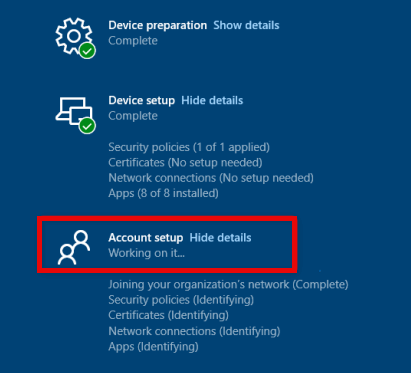
How the New Company Portal Could Enhance Onboarding
The “revamped” Company Portal UI improves how users interact with app installations and compliance checks. Instead of waiting for the traditional ESP to complete its phases (which, let’s be honest, can cause a lot of issues), users could be greeted with a more dynamic interface that provides real-time feedback.
By configuring the Autopilot Enrollment flow to rely on the Company Portal, you’re giving users a better experience:
- Clear and transparent: Your users can see the installed apps and track their progress of they are still installing.
- Efficient and Informative: Compliance checks and device readiness are communicated directly.
- Intuitive: Users are asked to take action if necessary, reducing IT support queries.
Integrating the Company Portal into your onboarding strategy enhances efficiency and improves the user experience. Since this functionality is not yet available, here’s how to implement it yourself!
Automatically start of the Company Portal
As mentioned above, Microsoft announced this feature at Ignite, but it’s not available yet. While the feature is still in development, let’s explore how to enable it ourselves! To do so we need to start with ensuring that the user status page (for APv1) will be skipped!
Skipping the User Status Page (APv1 Only)
The first step in automatically starting up the Company Portal after login is skipping the User Status Page unless you use Autopilot Device Preparation (AP-DPP). With AP-DPP, the account setup phase is already skipped, which pretty much confirms Microsoft’s intent to phase out the user status page (Account Phase) entirely.
By configuring a CSP to disable this step (SkipUserStatusPage), you allow the Company Portal to handle app and compliance statuses. This approach streamlines the flow and ensures a smoother user experience.
- OMA-URI ./Device/Vendor/MSFT/DMClient/Provider/MS DM Server/FirstSyncStatus/SkipUserStatusPage
- Choose Boolean as Data type
- Choose True as Value
Just to clarify: We’re NOT skipping the Device ESP here, only the User ESP (which, let’s be honest, is broken half the time anyway). This ensures that all your Autopilot-required and device-targeted apps, like Office, VPN tools, and more, are still properly installed on the device as expected.
Once the SkipUserStatusPage setting is configured, it will be applied to the device and recorded in the FirstSync registry key.
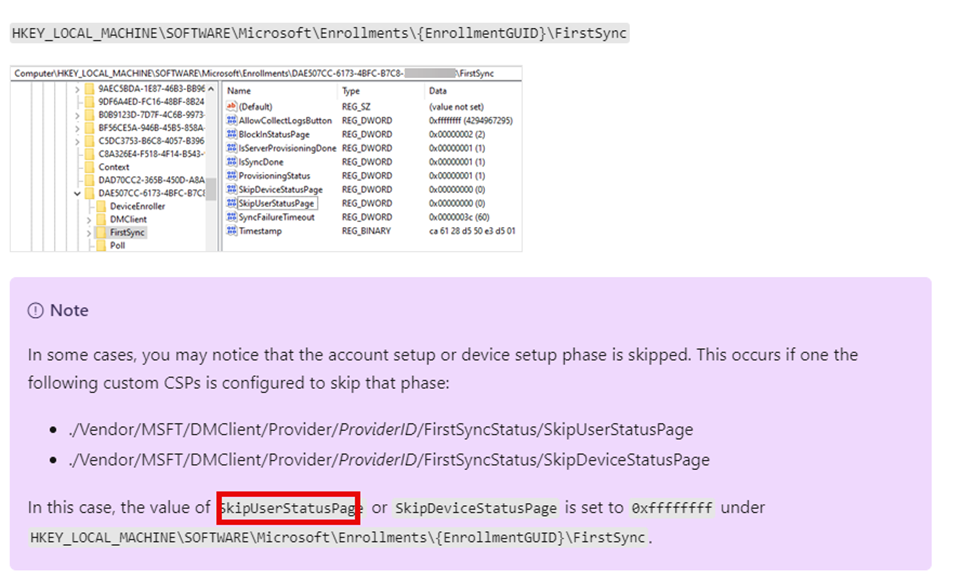
That’s a key detail we’ve touched on before, right? If not, you’ll want to check out this blog, it dives deep into how the ESP evaluates and progresses through its phases. With SkipUserStatusPage configured, the next step is to ensure the Company Portal launches automatically on the first login. But how do we make that happen for APv1 and APv2???
Configuring the Automatic Startup of the Company Portal
Here’s the catch: there’s still no built-in feature to automatically startup the Company Portal automatically after the first boot (even though it was announced at Ignite, it’s not here yet). That’s where a little customization comes in. By configuring the Company Portal as a Line of Business (LOB) app in the device context and using a PowerShell script, you can auto-launch it after login.
Step 1: Adding The Company Portal App
Let’s start by adding the Company Portal app to Intune
- Download the LOB version of the Company Portal.
- Deploy it through Intune and assign it to devices, and ensure the Install Context is set to: Device Context

- Ensure the app is included in your Autopilot APv1 profile as a required app or the Autopilot Device Preparation Profile if you’re using APv2
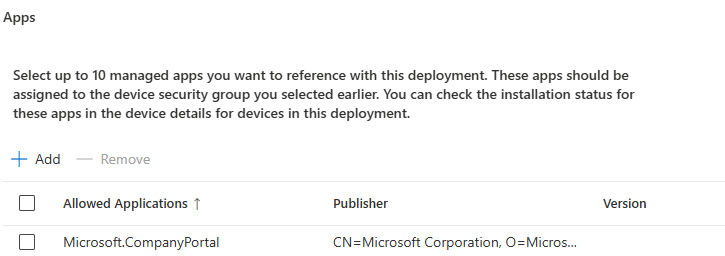
Once configured, I also needed to ensure that the Company Portal app would be automatically launched when the user logs in to Windows—and only once! To do so, I needed a PowerShell script (works for APv1 and Apv2)
Step 2: The PowerShell Script to automatically start the Company Portal
# Path to store the PowerShell script
$scriptsFolder = "C:\Scripts"
$scriptPath = Join-Path -Path $scriptsFolder -ChildPath "LaunchCompanyPortal.ps1"
# Path to the All Users Startup folder
$startupFolder = "C:\ProgramData\Microsoft\Windows\Start Menu\Programs\StartUp"
$shortcutPath = Join-Path -Path $startupFolder -ChildPath "LaunchCompanyPortal.lnk"
# Ensure the scripts folder exists
if (-Not (Test-Path -Path $scriptsFolder)) {
New-Item -ItemType Directory -Path $scriptsFolder -Force | Out-Null
Write-Host "Scripts folder created: $scriptsFolder"
} else {
Write-Host "Scripts folder already exists: $scriptsFolder"
}
# Define the content of the LaunchCompanyPortal.ps1 script
$scriptContent = @"
# Define the registry key and value for the flag
`$regPath = `"HKCU:\Software\CompanyPortalLauncher`"
`$regValue = `"Launched`"
# Check if the flag is already set in the registry
if (-Not (Test-Path -Path `$regPath) -or -Not (Get-ItemProperty -Path `$regPath -Name `$regValue -ErrorAction SilentlyContinue)) {
# Launch the Company Portal
Start-Process `"companyportal:`"
# Set the registry key to indicate the script has run
try {
New-Item -Path `$regPath -Force | Out-Null
Set-ItemProperty -Path `$regPath -Name `$regValue -Value `$true
Write-Host `"Registry flag set: `$regPath`"
} catch {
Write-Host `"Error setting registry flag: `$($_.Exception.Message)`" -ForegroundColor Red
}
} else {
Write-Host `"Company Portal has already been launched for this user. Skipping.`"
}
"@
# Create the PowerShell script in the scripts folder
try {
Set-Content -Path $scriptPath -Value $scriptContent -Force
Write-Host "PowerShell script created at: $scriptPath"
} catch {
Write-Host "Error creating script: $($_.Exception.Message)" -ForegroundColor Red
exit 1
}
# Create a shortcut in the Startup folder
try {
# COM Object to create the shortcut
$WshShell = New-Object -ComObject WScript.Shell
$shortcut = $WshShell.CreateShortcut($shortcutPath)
# Properly escape arguments for cmd.exe and hide the powershell window
$cmdArguments = "/c start /min `"`" powershell.exe -NoProfile -WindowStyle hidden -ExecutionPolicy Bypass -File `"$scriptPath`""
$shortcut.TargetPath = "cmd.exe"
$shortcut.Arguments = $cmdArguments
$shortcut.WorkingDirectory = $scriptsFolder
$shortcut.Save()
Write-Host "Shortcut created at: $shortcutPath"
} catch {
Write-Host "Error creating shortcut: $($_.Exception.Message)" -ForegroundColor Red
exit 1
}
# Final success message
Write-Host "The LaunchCompanyPortal.ps1 script and its shortcut have been deployed successfully." -ForegroundColor Green
This PowerShell script performs the following tasks:
Creates a Scripts Directory: Ensures the C:\Scripts folder exists, creating it if necessary.
Defines a PowerShell Script: Creates a script named LaunchCompanyPortal.ps1 in the C:\Scripts folder. This script:
- Checks a specific registry key (
HKCU:\Software\CompanyPortalLauncher) to see if the Company Portal app has already been launched for the current user. - Launches the Company Portal app (
companyportal:) if the registry flag does not exist or indicates it hasn’t been launched yet. - Sets a registry flag to record that the app has been launched for the user.
Creates a Startup Shortcut: Adds a shortcut named LaunchCompanyPortal.lnk to the All Users Startup folder (C:\ProgramData\Microsoft\Windows\Start Menu\Programs\StartUp). The shortcut:
- Executes the
LaunchCompanyPortal.ps1script silently during user login using PowerShell with cmd.exe /c /start /min
Logs Success or Errors: Provides feedback during each step of the process (script creation, registry flag setting, shortcut creation), outputting messages to the console for troubleshooting.
Automates Company Portal Launch: This ensures that the Company Portal app automatically launches during startup only if it hasn’t been launched for the current user before.
It is obvious we still need to configure/upload the script, so let’s do so!
Step 3: Configuring the Auto Launch Script
I uploaded the PowerShell script to Intune, which you will find below, and ensured it would run in the system context.
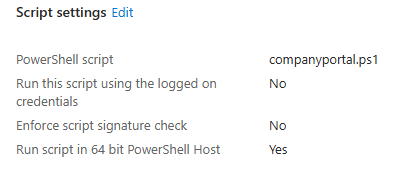
Also, please ensure you assign it to the proper device group. So, for Autopilot Device Preparation, this is the Enrollment Time group you also configured in the AP-DPP Profile.
If you are using AP-DPP, you also need to ensure that after uploading and assigning the script, it is also added to the AP-DPP Profile as an allowed script. (otherwise, it won’t be executed during AP-DPP)

The Startup Delay issue
With the prerequisites configured, the next step is to ensure the Company Portal launches immediately upon first login. Initially, the PowerShell script placed a shortcut in the Startup folder, which worked, but not as expected.
Instead of launching instantly, there was a frustrating 60–90 second delay.
At first, I thought: “What’s causing this lag? The shortcut is in the right place, so why isn’t the Company Portal opening the moment the desktop loads?” This led me to dig deeper into Windows startup behavior.
Why the Delay Happens
By default, Windows 11 staggers the launch of startup applications to optimize system performance. This process is controlled by the WaitForIdleState registry setting, which delays startup tasks until Windows considers the system to be idle.
While this helps prevent system overload during login, it unnecessarily holds back the Company Portal from launching when users need it most.
The Fix: Disable the Startup Delay
To force an immediate launch, we need to adjust a registry key that controls startup delays.
PowerShell Script to Disable Startup Delay
# Path to the registry key
$regPath = "HKCU:\Software\
Microsoft\Windows\CurrentVersion\Explorer\Serialize"
# Ensure the registry key exists
if (-Not (Test-Path -Path $regPath)) {
New-Item -Path $regPath -Force | Out-Null
Write-Host "Registry key created: $regPath"
}
# Set the WaitForIdleState value to disable delay
Set-ItemProperty -Path $regPath -Name "WaitForIdleState" -Value 0 -Type DWord
Write-Host "WaitForIdleState set to 0 to disable startup delay."
# Optionally set StartupDelayInMSec to 0
Set-ItemProperty -Path $regPath -Name "StartupDelayInMSec" -Value 0 -Type DWord
Write-Host "StartupDelayInMSec set to 0 to further reduce delay."
Write-Host "Startup delay registry changes applied successfully." -ForegroundColor Green
What This Script Does
- Ensures the Registry Key Exists: Creates the
Serializeregistry key underExplorerif it doesn’t already exist. - Disables Startup Delay: Sets
WaitForIdleStateto0, preventing startup delays for scripts and apps. - Optional Delay Reduction: Sets
StartupDelayInMSecto0for an even faster launch.
With this tweak, the Company Portal now launches almost instantly after login, no more unnecessary waiting!
DMA Continue to Sign in
For people outside the US, Microsoft needed to implement some additional windows to comply with the DMA.
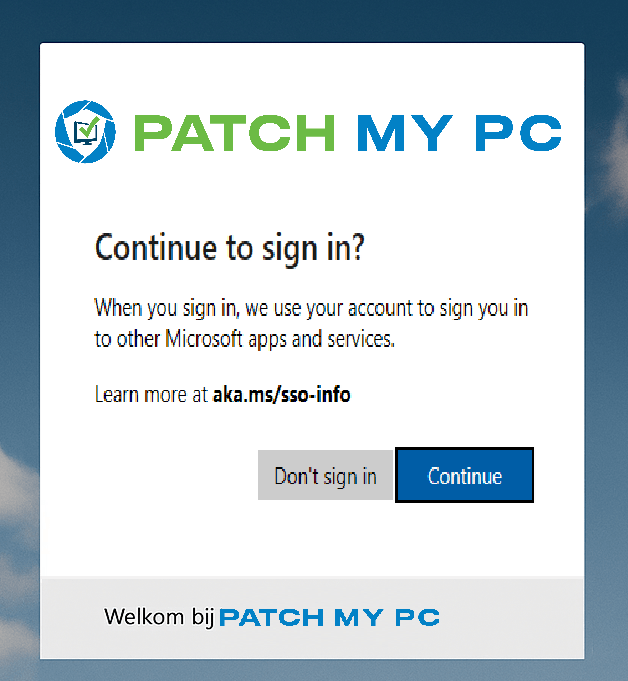
This caused the company portal to also show the screen above. This behavior impacted the user experience quite a lot. With the user needed to first press continue before the company portal showed the status of their device.
Luckily there is also a fix for that one!! Go read this blog to find out why this happens for companies based in Europe and how to fix it!
The Results
I decided to record it and showcase the results—it’s much easier than trying to explain how it works!
And the funny thing about this solution? We can also use the same approach for other processes that need to be executed when the user logs in to the device for the first time!
The Summary
In summary, here’s what needs to be done to ensure the Company Portal launches automatically after enrollment
If you are using Autopilot V1,
- You need to configure the SkipUserStatusPage setting
- You need to ensure you upload the MSI
- You need to Upload Both PowerShell Scripts (AutoStart and Fix Delay)
If you are using Autopilot Device Preparation
- You need to ensure you upload the MSI and assign it to the enrollment time group
- You need to Upload Both PowerShell Scripts (AutoStart and Fix Delay)
- Assign both PowerShell scripts and the MSI app to the AP-DPP Profile as allowed app and PowerShell Script
Wrapping It Up
By addressing the startup delay and automating the launch of the Company Portal, you can ensure users have instant access to app statuses and compliance updates right after logging in.
